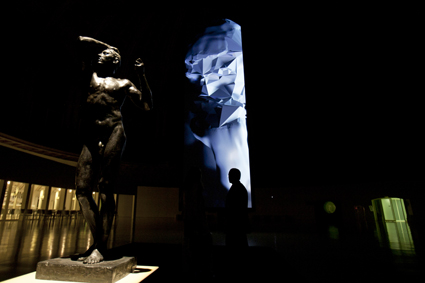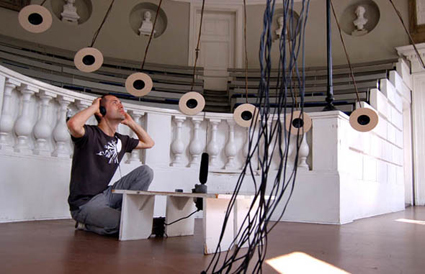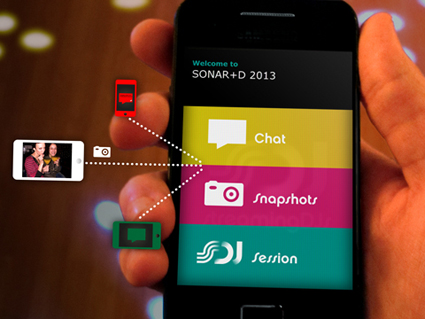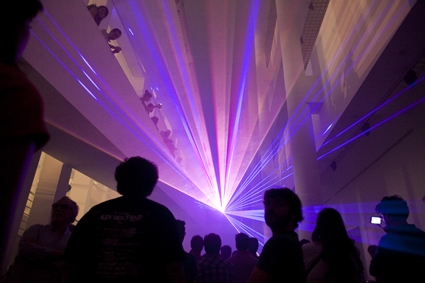 |
Davide Quayola, Matter, Sónar 2013 photo Consuelo Bautista |
I've not seen anything more grandly presented than Davide Quayola's Matter, as viewed at sunset. I ascended to the marvelously overstated domes of Catalunya National Museum of Art via four flights of Olympic-grade stairs, past the Font Màgica and sculpted formal gardens. I was then ushered past curtained and closed galleries into a colossal, tiered, domed and nearly empty hall where a 12-metre projection screen hung with a Rodin bronze in front. Name notwithstanding, Matter is an essay in pure form: the subject is a digital recomposition of Rodin's Thinker, skewed by staccato glitches and mutations, stripped back to skeletal polygons. A soundtrack of similarly glitched harmonies by Matthias Kispert invites quiet contemplation of this digital excoriation of form. What is the minimal number of bits needed to evoke the classic Rodin work? It's not far from that fashionable lo-fi video mangling technique "datamoshing," but this one is strictly for the Blu-ray set. With this much build-up for a work, nothing but a 12-metre screen will do. I mean, eleven-and-a-half won't cut it when there are two separate thronging break-dancing competitions outside. In scale and contrast alone, this simple work has a mammoth effect.
 |
Jacob Kierkegaard, Labyrinthitis, Sónar 2013 courtesy CosmoCaixa |
For both these offsite Sónar works a highlight is their apposite placement amid this extravagant and personable city. But even Barcelona has bleak concrete sheds to wall out the cityscape for banal corporate events and the like, and this leads me to Sónar's onsite art, which is where things fall apart.
First of all, there's not much of it. Despite a floor crammed with notionally-creative-technology companies' newest product demonstrations, there is not much actual, well, art; certainly not "art" in the sense that one might go to a festival to experience—say, stuff that didn't come out as a smartphone app for $0.99 last year.
 |
Sónar 2013 Streaming DJs APP |
But there is an even less flattering comparison, just down the metro line, and definitely not part of Sónar: the large and top notch video-art exhibition This is not a love song at the La Virreina Image Centre, showcasing more permutations and perversions of the music video than are dreamt of here, in a thoughtful and lovingly curated show with a minute fraction of the budget of the festival. To drive the knife home: it's free admission.
Let's talk about this inward-looking tendency at Sónar in light of its obtrusively interesting surroundings. This is a country rocked by unrest. There is a 57% youth unemployment rate and rolling corruption scandals in a region with an upcoming secession referendum. Oh and by the way there are still aftershocks from Europe's freshest and longest dictatorship and yet the festival is politics-free. Then, in a city whose unique tapestry is threaded with architectural innovation old and new, Sónar opts for generic exhibition halls.
Outside are street protests, scandal, corruption, anti-capitalism, fascist revivalism, catholic fundamentalism. Outside there are cathedrals, boulevards and buskers, beer-drinking families watching skate-offs, grandmothers toasting the sunset in pleated skirts and a skyline marked by an intergenerational cadre of revolutionary architects. Inside, there are concrete walls and the eternal bar queue, and this most idiosyncratic of cities is made as bland as an airport lounge. There is nothing to startle the privileged customer base out of their global party with the hint of local flavour. I'm not demanding all my art be 'site-specific' but to turn such a fertile site into something so sterile is plain perverse.
But fine, we can ignore the suggestive locale in favour of bringing the best the world has to offer, thanks to the global reach and brand-power of this renowned festival. Right? Except Sónar's curatorial hand, it seems, has been supplanted by UK video producer Adam Smith's invisible hand. This is one of the most outrageously successful festivals on the planet to have "new media art" in its name. One hundred and twenty one thousand punters passed into the maw of this monster, putting its budget somewhere in the double-digit millions before sponsorship. Yet the content of the actual new media art program in no way reflects that. The echoing conference halls that Sónar has occupied are mostly filled with banners from the booze sponsor and for-cash booths for various start-up companies offering modestly interesting software for driving techno with your iPad.
Missing: commissions, experiments, thrills. There are some promising student semester works from the local university. There are some momentary events here and there like the laptop jam in a mostly-unused cinema. That's it, really. Mostly, the few works are okay, but the curation is… well… It is as if, a week before raising the curtain, someone noticed the words on the flyer, and decided it would be cheaper to commission a half-dozen unrelated works to tick that box than to reprint the promo material. You know, as long as it doesn't get in the way of the festival-run-monopoly beer-tent. And by the way, please pat-search everyone at the gate while checking their two hundred euro tickets. And THAT is why, even as the gate security drain one friend's water bottle and confiscate another's contraband apple at the gate, I skive in on a press pass with my trousers stuffed with illicit citrus liqueur.
But enough. This is sufficient bile, or nearly so. For though the program is perfunctory as compared with the hype, there are one or two events on the closing night that are worth mentioning. For one, who can fail to love Max Richter's reboot of the Vivaldi franchise, performed live? Four Seasons recomposed has no enemies. As lounge-room-loveable as the original but so much more hip; seeing it with real live violins right there really takes the sting out of the Naxos guilt.
 |
Lorenzo Senni, ORACLE, Sónar 2013 Photo Oscar Garcia |
Sónar, 20th International Festival of Advanced Music and New Media Art, Barcelona, 12-16 June 2013; http://www.sonar.es/en/2013/
This is not a love song, curator F. Javier Panera, La Virreina Centre De la Image, 22 May- 29 September 2013; http://lavirreina.bcn.cat/en/exhibitions/not-love-song
RealTime issue #115 June-July 2013 pg. web
© Dan MacKinlay; for permission to reproduce apply to [email protected]








 back
back